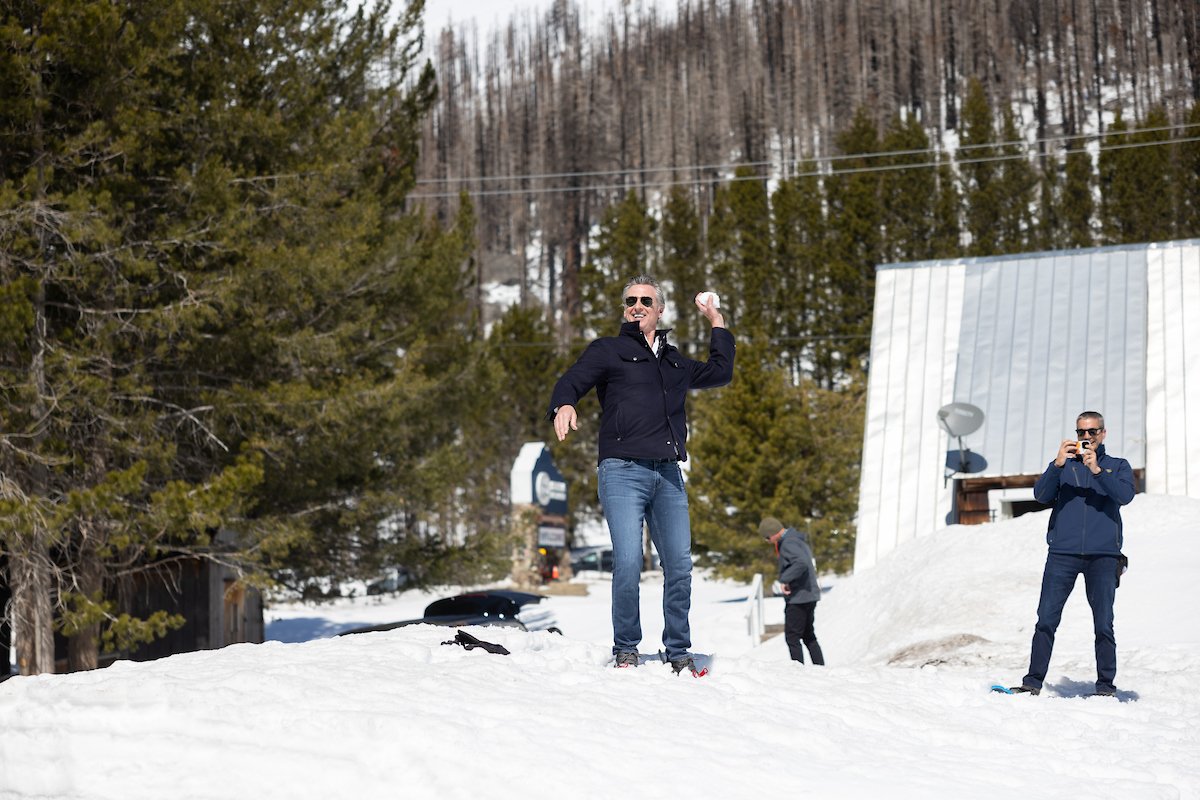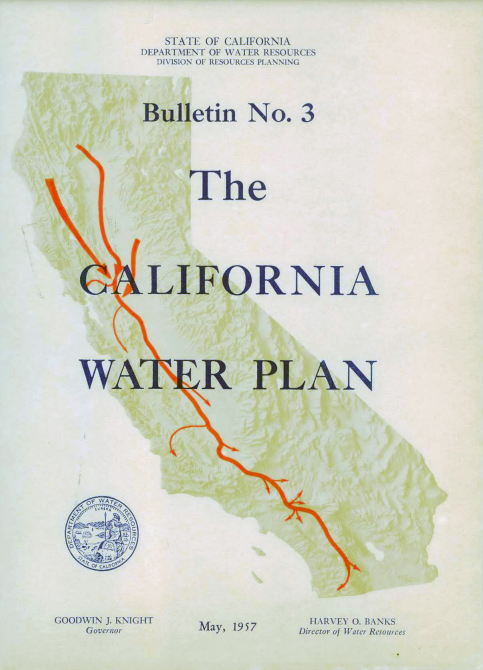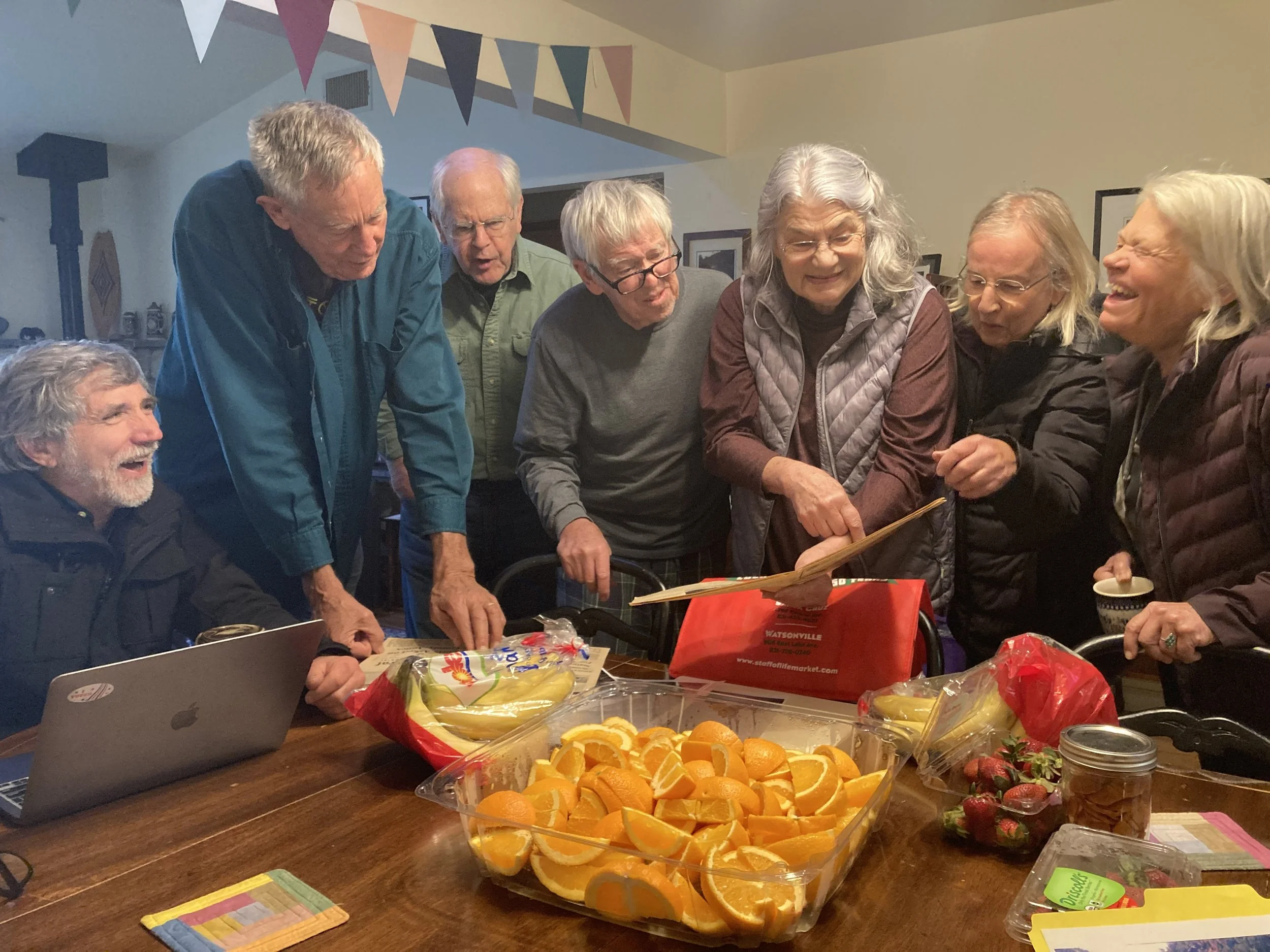Currents - April 2024
Editor’s note: FOR staff are extremely focused on our policy work right now, and thus, this month’s “Currents” articles are brief and combined as one. We want to keep your finger on the pulse of California water happenings and our efforts, while honoring the incredible workload on our plates right now. Thanks for joining us on this journey.
Gov. Newsom, a former college baseball player, throws a snowball following the California Department of Water Resources’ fourth snow survey of the season on April 2, 2024. Credit: Andrew Nixon, California Department of Water Resources
An average water year
The end is in sight for California’s water year. The result, pretty much average, although the south state got some memorable big rain storms.
Of course average is not exactly normal, the loosely applied term that is not as mathematically precise as average (arithmetic mean). Here in the golden state, “normal” is often rather dry and occasionally rather wet.
Yes, there are a couple more months of potential rain before the Mediterranean-climate summer drought that hits most of the state begins in earnest. But we don’t expect much rainfall in April and May. And the water year ends on September 30, before the fall rains typically return in earnest.
But in the meantime, there will be wildflowers, melting snow, and rivers to enjoy.
Of course at the same time the beneficiaries of the state’s big taxpayer subsidized water systems will be complaining that the state’s plumbing is not big enough to guarantee them all the water they desire.
There is nothing new under the sun.
California State Capitol. Credit: Ron Stork.
What’s up in the legislature?
Well, some things work out. Assemblyman Alanis (R-Modesto) is said to have pulled from consideration his proposed constitutional amendment (ACA-2) to require that 1.5% of California’s general fund be devoted to water projects. Amounting, to $3 billion per year, dams were on his taxpayer spending-spree list.
In contrast, a couple bills implementing proposed modifications of the California Water Code from a blue ribbon group of water law professors still have a chance of making its way through the legislature (AB 460 and AB 1337)(1).
FOR old-timers will remember a similar, but by no means identical water-law reform effort, put together under the first Governor Jerry Brown and packaged in a statewide ballot measure (Proposition 13). Not so well hidden in the package was protection for the Camp 9 reach of the Stanislaus River threatened by the filling of the then new federal New Melones Reservoir. The initiative failed.
On a more special-interest front, State Senator Marie Alvarado-Gil (D-Modesto) introduced SB 1360 to require the State Water Resources Control Board to issue water quality certifications without environmental reviews if such reviews might cause the aspiring owners of an energy project (such as a pumped-storage hydroelectric project) to become ineligible for federal tax credits.
Not the best idea, and another bill that may not advance very far. Or at least one might hope.
A controlled spillway release from the earth-filled McCloud Dam built on the McCloud River in California. The facility was finished in 1965 by Pacific Gas and Electric to control water flows and for hydro-electric power. Photo taken May 8, 1975. Credit: D.L. Christensen, California Department of Water Resources.
PG&E stumbles — perhaps
Northern California’s giant investor-owned utility, the Pacific Gas & Electric Company (PG&E), has had its troubles.
In 2001, it went into bankruptcy as a result of the state’s dalliance with energy utility deregulation. Eagerly, PG&E sold off much of its thermal (natural-gas-fueled) plants and hoped to buy the energy back from the new owners at low prices. Instead, it got taken to the cleaners by the slick operators like ENRON of its former plants.
It 2017, it declared bankruptcy because of damages it was forced to pay from huge wildfires and urban fringe fires caused by failures of its equipment, fires that continue to dog the utility.
To raise some cash, PG&E proposed to spin off much of its non-nuclear generation to a new subsidiary, Pacific Generation, for which it would retain a 51% ownership share.
The proposal, of course, raised questions on what would remain of PG&E’s hydroelectric dam and responsibilities with such large “silent” partner — rumored to be Warren Buffet’s PacifiCorp.
Friends of the River and its environmental group partners chose to participate in the resulting proceedings in the California Public Utility Commission (CPUC). We managed to persuade the Administrative Law Judge overseeing the proceeding to issue a proposed order rejecting PG&E’s idea(2).
PG&E is fuming, but we will soon see whether the Commission will accept the recommendation.
Just another day in the life of Friends of the River.
Want to protect 500 miles of California rivers by asking the CPUC to reject PG&E’s proposal? Click here.
Cover of Bulletin No. 3, the “dam-everything-in-sight first California Water Plan,” visually depicting an overarching strategy to export water from north to south. Public domain.
Another California Water Plan
Starting inauspiciously in 1957 with the publication of Bulletin #3, the dam-everything-in-sight first California Water Plan, the plan has been updated from time to time by a little noticed cottage industry of California Division of Water Resources staff, water industry insiders, and a small army of consultants.
In recent decades, the plan has been expected on a five-year timeline (like the old Soviet Union’s five-year plans?). They have never been as bad as Bulletin #3, but the plans have often been a vehicle to establish the state governor’s priorities, and we have had a lot of governors mostly interested in expanding the reach of the state water project and dams, diversions, and canals to serve the interests of the state’s politically powerful irrigation and municipal water districts.
The recently released plan was no different, although California being California, each plan has to discuss how green it is — as well as advance the Governor’s stated goals of building more taxpayer-subsidized dam and canal infrastructure.
As might be expected, the Sites Authority is touting the consistency of its proposed $4 billion 1.5 million acre-foot Sites Dam and Reservoir with the brand-new California Water Plan.
There is nothing new under the sun.
Antelope Valley, located west of Maxwell, CA, is the location of the historic Sites township and rangeland. The proposed Sites reservoir threatens to drown this valley and its cultural heritage. Credit: Greg Kareofelas, 2015.
Sites water rights hearings begin to roll
The biggest new reservoir proposed in decades has gone to hearing. Well, not quite.
The protests are in before the State Water Rights Control Board’s Administrative Hearings Office. The Notice to Appear in future hearings are all in. We’ve just had the first pre-hearing conference. That’s where the parties argue over what subjects, timelines, and procedures await us.
The hearing officer’s admonition to all of us is “that we all are going to be spending a lot of time together.”
That is going to be true. But this proposed project is the biggest new transfer of water from the north state to the south state in decades, well, a few short years since Governor Brown’s twin tunnels and Governor Newsom’s single tunnel under the Sacramento/San Joaquin River Delta is very much active.
Indeed, the Board has just started the clock for potential participants in its upcoming water rights proceeding for the single tunnel diversion under the Delta. Man, are we going to be busy.
Longtime Stanislaus advocates gather at the Restoring the Stanislaus Symposium. From left to right: Kevin, Mark Dubois, Larry, Fred, Cris Barsanti, Jacqueline (Jackie) Dennis, Jayne Childress.
Reuniting for the Stanislaus - Jann Dorman
On Saturday, April 6 about 100 people came together to learn about the current situation in the Stanislaus watershed and the operations of its dams, including New Melones. Participants explored what it will take to redesign the watershed and the operations of New Melones Dam to restore the river and its tributaries to health. In the evening session, participants heard from Klamath River tribal and environmental representatives how they achieved the world's largest river renewal project, how they are bringing back the salmon, as well as their complex strategies for ensuring a successful restoration of their river.
Kevin Wolf, former Director of Organizing for Friends of the River and now President of Restoring the Stanislaus River, which put on the symposium, said "By restoring the ability of the Stanislaus watershed to store and release water in the face of climate change, all stakeholders can benefit, including the animals, plants, fish, tribes and water and power beneficiaries. New Melones Dam is overbuilt. By restoring the ability of meadows and forests to retain and slowly release water, plus the opportunity to increase the conjunctive use of dam operations and groundwater storage, we can mitigate the negative impacts of extreme drought and flood events.”
Friends of the River is excited to collaborate on this exciting opportunity to help restore river and help the Stanislaus watershed better adapt to climate change.






